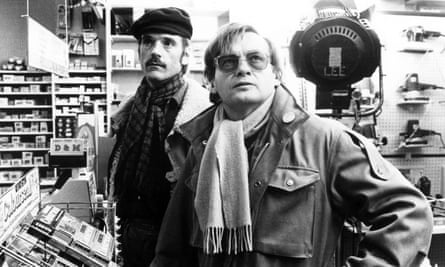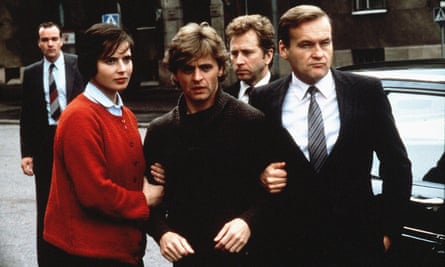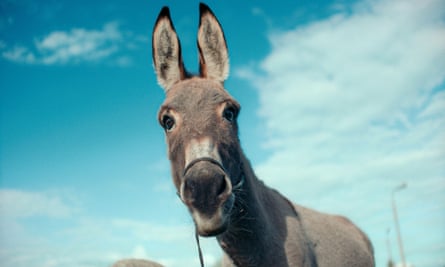In his rolling, sonorous, Polish-accented English, veteran director Jerzy Skolimowski explains how he became a donkey whisperer. “I make a very close bond with the animal,” he says. “Every time I was not doing anything else, I sit with donkey. I look very closely at him, eye to eye. I speak to donkey, talking in his ears gently. All my free time I spent with donkey.” There is a reason for describing this inter-species bonding: Skolimowski is about to release his amazing new film that features a donkey as the main – indeed, only significant – character; its title is simply EO, designed to imitate a donkey’s bray.
Skolimowski, 84, obliges – “Ee-oh! Ee-oh!” – but seems unaware of the full extent of donkey-related sentiment that will undoubtedly be rolling his film’s way, in the UK at least. He and his wife – EO’s co-writer and producer Ewa Piaskowska – might know a little about the British adoration for donkeys, but they may be unaware that £60m (mostly in wills) was given to the Donkey Sanctuary in Devon last year. If even a tiny fraction of that money transmits to the box office, Skolimowski could have a hit on his hands.
If he does, it will be a long time coming. The last time Skolimowski made a comparable level of commercial noise was in the early 1980s with Moonlighting, when he persuaded Jeremy Irons to play a (slightly unlikely) Polish builder doing a reverse Auf Wiedersehen Pet, leading a crew of illegal workmen who get stuck in the UK after martial law is declared back home. No doubt the political backdrop, with Poland convulsed by anti-communist protest, gave the film its extra charge. But it formed part of Skolimowski’s amazingly rich mid-career period spent in the UK that included future cult classics Deep End and The Shout. And all this after he made his name in the 60s Polish new wave, writing and acting in films for compatriots Andrzej Wajda and Roman Polanski, before making his own series of loose-limbed, Truffaut-ish films about a young man closely resembling Skolimowski grappling with life in cold war era Poland.
In fact, as Skolimowski tells it, it was his early Polish films that got him on the donkey track in the first place, by pushing him to go and see the film that EO most closely resembles: Robert Bresson’s 1966 donkey-centred meditation on human cruelty, Au Hasard Balthazar. His second film Walkover, he says, had been picked by Cahiers du Cinéma as the second best film of 1966; so he went to see the one that beat him. “It was the only time I had tears in my eyes seeing a film,” he says. “Never before, never after. Normally I watch things as a professional, seeing how they are made, and I don’t allow the emotions to manoeuvre me. But the big lesson Bresson taught me is that the animal character can move the viewer more strongly than big human drama.”
Skolimowski and Piaskowska wave away suggestions that – donkey or not – EO has much of a relationship with Au Hasard Balthazar. “As a matter of fact,” says Skolimowski, “we were doing everything to get away from it. Bresson’s film is set all in one place, while ours has the structure of a road movie. Bresson was a minimalist, the whole film was shot with one lens. I couldn’t do that: I have colour, camera moves, different locations.” Piaskowska talk’s up EO’s emotional content: “Bresson’s film was an intellectual exercise, a lesson in morality; here we are all about feelings.”

But how, I wonder, do you get a performance out of a donkey? “It’s not acting, that’s the big thing,” says Piaskowska. Every scene, Skolimowski says, was shot from the donkey’s point of view, as well as the more objective “master”. “It was amazing to see on the monitor, while we were shooting, how different it looks through the donkey’s eyes. It put an additional dimension into the meaning.” Four near-identical Sicilian donkeys were employed, along with some basic animal-wrangling techniques: if they wanted a shot of a donkey moving from A to B, says Skolimowski, they’d put a female donkey on point B, and a male donkey on point A, and sure enough the male would wander over. “Donkeys have the reputation of being stubborn and stupid – stubborn yes, and sometimes very stubborn – but stupid, no.”
This is where Skolimowski’s donkey whispering came in useful. “My directing technique was to be as close as possible to the animal.” The way he tells it, it was practically a spiritual experience. “I went through a very strange sensation. I felt that the donkey felt the same as I do – I would call it a sense of co-existence. In that moment, there are two of us: here we are, you and myself, myself and you. I see something very specific in donkey’s eye, and this is why we use it a lot in the film.”
EO’s success – which so far includes the jury prize at Cannes, a best director nomination for the European film awards, and Poland’s entry for the best international film Oscar – is all the more remarkable given Skolimowski walked away from film-making in the early 90s, only to return to directing17 years later in 2008, with Piaskowska on board as co-writer and producer. “It was simple,” he says. “I made a film I was so unhappy with that I felt I betrayed myself. It was the wrong choice, badly executed. We don’t need to mention the title.” (It doesn’t take much detective work to establish the film in question is Ferdydurke, his 1991 adaptation of Witold Gombrowicz’s cult novel.) “I didn’t put my heart into it and the result was very poor.” Skolimowski says he only intended to take a year or two off, but found painting rewarding enough to develop it as an alternative career: “I made really rapid progress: I start to have exhibitions, start to sell paintings. That really encouraged me to work hard and I renew my artistic freshness. Then I go back to film-making.”

Skolimowski doesn’t seem too interested on elaborating how his striking paintings may have influenced EO’s distinctive visuals – bold colours, fluidly improvisatory camera moves, hallucinatory dream-images – but he is keen to talk about one of his more unlikely ventures, a role as a Russian nasty in superhero blockbuster The Avengers. “It was like an exotic journey for me, like a trip to the Himalayas,” he says. He thinks he was offered the job – in which he gets to preside over the attempted torture of Scarlett Johansson’s Black Widow, and is thoroughly beaten up for his trouble – because of his mid-80s acting role as a KGB officer in White Nights, the ballet-defector drama starring Mikhail Baryshnikov (“they must have me on some Russian villain list”).
He says he took the role as “as an act of curiosity”. “I was never before even on the set of such a big production. I was rather curious to observe the technique of working, the procedures, the discipline. Different scale, almost different attitude. It was a factory – a factory producing perfect product that was really planned down to the last element, and executed precisely. I could never do this: I am always open to something happening, to improvisation.”
Apart from anything else, EO is a monument to Skolimowski’s commitment to improvisation, to his ability to handle the animals and come up with extraordinary visual passages seemingly on the fly. His main plan, he says, was to use the film to “discreetly smuggle” the message about his horror of animal abuse (though not quite enough to turn him fully vegetarian, it turns out). “I think,” he says, “the film proves it was made with a full heart. We were really involved with it emotionally, and these emotions are there on the screen. that would be the success for this film: not the number of viewers or the box office, but that people will be touched by the fact those are living creatures, and lovely creatures.”

